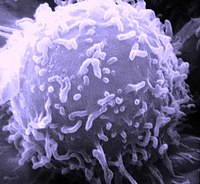
Photo from wikipedia
Transcriptome data can provide information on signaling pathways active in cancers, but new computational tools are needed to more accurately quantify pathway activity and identify tissue-specific pathway features. We developed… Click to show full abstract
Transcriptome data can provide information on signaling pathways active in cancers, but new computational tools are needed to more accurately quantify pathway activity and identify tissue-specific pathway features. We developed a computational method called “BioTarget” that incorporates ChIP-seq data into cellular pathway analysis. This tool relates the expression of transcription factor TF target genes (based on ChIP-seq data) with the status of upstream signaling components for an accurate quantification of pathway activity. This analysis also reveals TF targets expressed in specific contexts/tissues. We applied BioTarget to assess the activity of TBX21 and GATA3 pathways in cancers. TBX21 and GATA3 are TF regulators that control the differentiation of T cells into Th1 and Th2 helper cells that mediate cell-based and humoral immune responses, respectively. Since tumor immune responses can impact cancer progression, the significance of our pathway scores should be revealed by effective patient stratification. We found that low Th1/Th2 activity ratios were associated with a significantly poorer survival of stomach and breast cancer patients, whereas an unbalanced Th1/Th2 response was correlated with poorer survival of colon cancer patients. Lung adenocarcinoma and lung squamous cell carcinoma patients had the lowest survival rates when both Th1 and Th2 responses were high. Our method also identified context-specific target genes for TBX21 and GATA3. Applying the BioTarget tool to BCL6, a TF associated with germinal center lymphocytes, we observed that patients with an active BCL6 pathway had significantly improved survival for breast, colon, and stomach cancer. Our findings support the effectiveness of the BioTarget tool for transcriptome analysis and point to interesting associations between some immune-response pathways and cancer progression.
Journal Title: Scientific Reports
Year Published: 2019
Link to full text (if available)
Share on Social Media: Sign Up to like & get
recommendations!